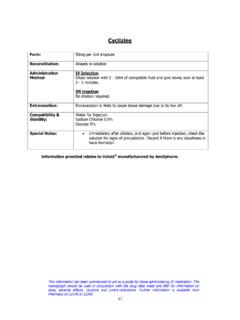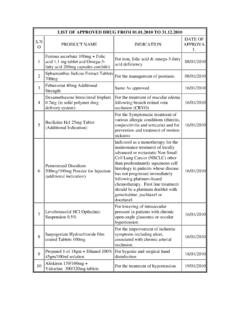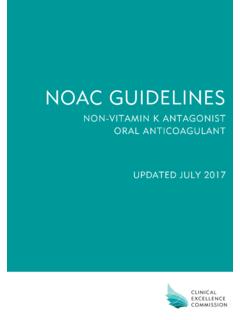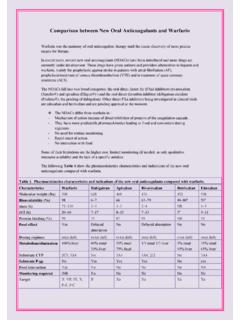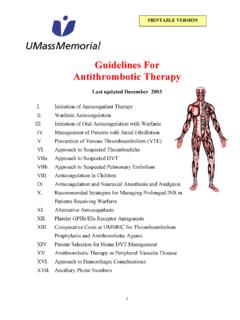Transcription of Thromboprophylaxis Guidelines for Adult Patients in - EMed
1 Thromboprophylaxis Guidelines for Adult Patients in: Medicine, Haematology & Oncology, Intensive Care Unit, Surgery, Orthopaedics, Major Trauma. 2015 Dr. Khan and Shea on behalf of Hospital Thrombosis Group (HTG) Cork University Hospital 6/3/2015 Title Thromboprophylaxis Guidelines for Adult Patients Number 1 Approved by Hospital Thrombosis Group Approval Date 03/06/2015 Issue Date 08/06/2015 Review Date 07/06/2017 Author (s) Dr Khan & Dr O Shea on behalf of Hospital Thrombosis Group (HTG)
2 Cork University Hospital HSE 2 CUH/version 1 26/05/2015 GUIDELINE Table of Contents 1. Thromboprophylaxis Guidelines 4 Inclusion criteria 4 Exclusion criteria 4 Targeted professional group 4 2.
3 Introduction 5 3. Pathogenesis and natural history of VTE 5 4. Risk factors for VTE 6 Patient related risk factors (Box-1) 6 Admission related risk factors 6 Risk factors for bleeding (Box-2) 7 Reassessment of Patients risk of bleeding and VTE 7 5. Important points to remember 8 6. Risk stratification 8 7. Modalities available for VTE prophylaxis 9 Mechanical Thromboprophylaxis 9 Graduated compression stockings (GCS) 9 Intermittent pneumatic compression devices (IPCD) 10 venous foot pump devices (VFPD) 10 Pharmacological Thromboprophylaxis 10 Tinzaparin (LMWH)
4 11 Enoxaparin (LMWH 11 Unfractionated heparin (UFH)) 11 8. Timing of regional anaesthesia / analgesia 11 UFC (subcutaneous) 11 UFH (intravenous) 11 LMWH 11 9. Monitoring for heparin induced thrombocytopenia (HIT) 12 Cork University Hospital HSE 3 CUH/version 1 26/05/2015 GUIDELINE 10.
5 Patients with renal impairment on Thromboprophylaxis with tinzaparin 12 11. Obese (overweight) Patients on Thromboprophylaxis with tinzaparin 12 12. Thromboprophylaxis in medical Patients 13 General medical Patients 13 Patients with stroke 13 Patients with cancer 13 Patients with central venous catheters 14 Patients in palliative care 14 Patients in geriatric medicine 14 Patients in intensive care unit 15 13.
6 Thromboprophylaxis in surgical Patients 15 All surgery 15 Cardiac surgery 16 Gastrointestinal, Bariatric, Throracic and Urological surgery 16 Neurosurgery (cranial or spinal) 16 14 . Thromboprophylaxis in Orthopaedic Patients 17 15. Other patient groups 17 Major trauma 17 Spinal injury 17 Lower limb plaster cast 18 Patients taking antiplatelet agents or on anticoagulants at admission or needing them for treatment 18 16.
7 References 19 Cork University Hospital HSE 4 CUH/version 1 26/05/2015 GUIDELINE 1. Thromboprophylaxis Guidelines This guideline applies to Patients admitted to Cork University Hospital (CUH), NOT including Cork University Maternity Hospital (CUMH), which has its own specific Guidelines for pregnant patient (please see separate guideline for pregnant Patients ).
8 Inclusion Criteria adults (18 years and older) admitted to hospital as inpatient or admitted for day-case procedures. Including In- Patients with acute medical illnesses Surgical inpatients including trauma Cancer Patients Patients admitted to intensive care unit Patients admitted for day-case surgical or medical procedures Orthopaedic Patients Exclusion Criteria Patients younger than 18 years Patients attending the hospital as an outpatients Patients presenting to emergency department and acute medical assessment unit who are not admitted Patients admitted to the hospital with a diagnosis or suspected diagnosis of
9 Deep venous thrombosis (DVT) or pulmonary embolism (PE) Targeted Professional Groups All NCHDs responsible for the care of these Patients All consultants responsible for the care of these Patients All preoperative nurses planning Patients admission to hospital All pharmacists reviewing drug kardexes on the wards All anticoagulation nurses All ward staff nurses Cork University Hospital
10 HSE 5 CUH/version 1 26/05/2015 GUIDELINE 2. Introduction venous thromboembolism (VTE), which includes deep vein thrombosis (DVT) and pulmonary embolism (PE), is a major cause of preventable morbidity and mortality in hospitalized patients1-4. Hospital Acquired Thrombosis (HAT) has been defined as any VTE event occurring during or within 90 days of hospitalisation5.

